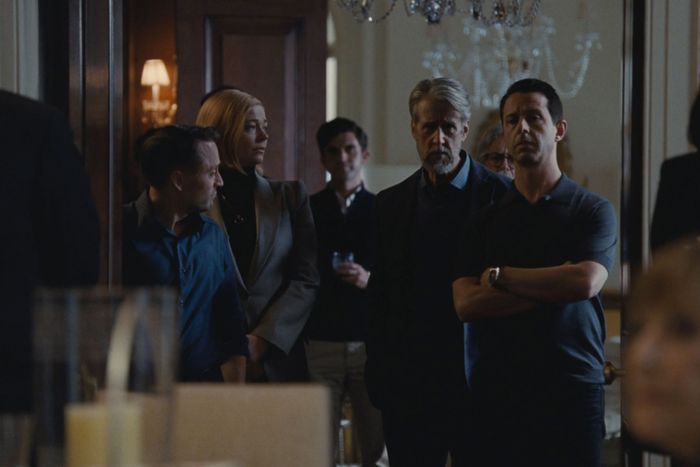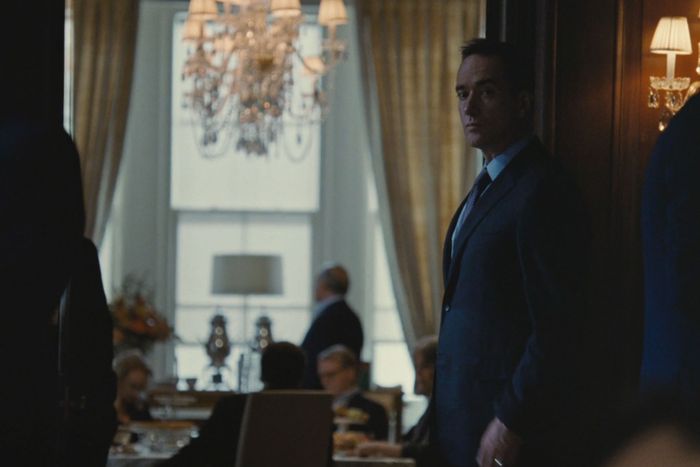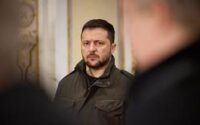Lorene Scafaria on Directing Without Logan
“It’s the first real delivery on the title of the show. What do you do when the person who creates the temperature in the room is no longer there?”
Photo: HBO
What does it look like when a familiar world, suddenly shattered, starts reassembling itself? More important, who will be in charge of that world? Those were the questions facing Lorene Scafaria when she signed on to direct “the one after The One” — the fourth episode of Succession’s final season and the first without Brian Cox, whose blistering billionaire patriarch, Logan Roy, died in the previous installment. “Honeymoon States” weaves a classic gathering episode through Logan’s rambling apartment; various relatives, acquaintances, power brokers, society vultures, and corporate executives move among the rooms and floors in ways that subtly comment on how much power each can exercise at any given moment. The most significant action, however, zooms in on an ambiguously annotated piece of paper, discovered in Logan’s private safe, which suggests he wanted his second-oldest son, Kendall (Jeremy Strong), to take over the company — though it’s hard to say for sure, because what highlights Kendall’s name on the document could be either an underline or a strike-through.
Previously, Scafaria directed season three’s “Too Much Birthday,” which found a miserable, ostracized Kendall throwing himself a lavish birthday party while alternating between manic and miserable. Some of the parameters for “Honeymoon States” are reminiscent of that assignment, notably the spatial constraints on the action, though this time, the set was much more compact than a rented space the size of a mall. Scafaria spoke about the challenges inherent in crafting a story around an absence and how the actors and crew rose to the occasion — including the show’s prop master Monica Jacobs, who had to create a document that was convincing no matter how the characters (and viewers) wanted to interpret it.
What were some of the similarities and differences between this episode and the last one you directed, “Too Much Birthday”?
I also did episode six this year, and all three of them are different. But all three focus on the siblings (Kendall, Shiv, and Roman) without dad in the room — although in this one, it feels like, even though he’s gone, he’s still pulling the strings. The last episode I did and this one were good for Kendall’s arc. His birthday debacle certainly focused on him going from the highest highs to the lowest lows, and this one is taking him from the lowest low to some kind of small victory. He’s getting in position.
Almost the entire story takes place in Logan’s house.
It really does — except for those brief opening scenes, when you get to see the siblings in the moment of reality the morning after. But yeah, this is a real bottle episode. There are seven spaces on the main floor — all kind of one large room. Then you’ve got the library upstairs and Logan’s study downstairs. Not a lot of bells and whistles in this one, and it’s all in real time, counting down to the board meeting that’s happening in an hour.
This is the second episode in a row when almost all of the significant action is more or less happening in real time, right?
Yeah! Something feels like it’s amping up this season. Most of the episodes seem to be happening within a day or 24 hours.
Have you ever told a story of this length, in which maybe 95 percent takes place in one location?
No. I mean, Kendall’s birthday had a little bit of that feeling, but there were more limitations on this that became a fun challenge — more so than constraints — thanks mainly to the script by Jesse Armstrong and Lucy Prebble. It was a bit daunting being “the one after The One,” you know, because that meant we were going to get the most eyeballs. People would want to see what happens after Logan is gone. In a way, it’s the first real delivery on the title of the show. It’s the first one where he’s truly gone. What do you do when the person who creates the temperature in the room is no longer there?
When I read the script, I took some inspiration from Clue — it’s got that murder-mystery vibe. And it kind of feels like a living, breathing Eugene O’Neill play. And a bit of a Scandinavian vibe sneaks in there in places, which is not what a Scotsman like Logan would have wanted.
Photo: HBO
What do the spatial restrictions do to the storytelling?
It was about creating claustrophobia and keeping that feeling alive. I thought about the apartment layout — how it’s a bit of a circle with a ring-around-the-rosie quality to it. There’s all this gravity pulling them in different rooms. Then everybody gathers together. On a show like this, a well-oiled machine where all the actors know their parts so well, it’s a joy to be thinking in terms of blocking.
Can you explain what blocking means in terms of filmmaking, where the camera can be anywhere, as opposed to blocking actors onstage, where everybody in the audience is looking at the performers from the same direction?
Blocking for film and TV is framing, composition, and storytelling. It’s about framing the actors in the shot as well as in relation to each other in their space so that the camera tells the audience where the story is going, who’s gaining or losing control, what’s happening in the relationships that’s not spoken, and the significance of objects.
Let’s talk about the objects.
It was a real joy for me to think about something like how to treat their dad’s chairs. For the scene in the study, I remember telling Kieran Culkin, “Maybe Roman would be sitting in it rather unceremoniously at the start.” It’s not really a power move, because the three siblings are on the same side at that point in the episode — compared to the end, when Kendall, even though he’s sitting on the arm of the chair, is taking a power position.
But really, the best solution some of the time was to try to get out of the way of these actors, and other times, to see if we could have a bit of fun in terms of where they are in a room, what level they’re on, the focus of the audience, and whom we’re tracking. There’s so much going on in their motions and in the thoughts behind their eyes, which I wanted to capture.
Photo: HBO
What kinds of precautions did you take to make sure that major plot information was heard on set on a need-to-know basis when you were filming a scene with a lot of characters in one space, more arriving or leaving, and lots of extras milling about?
For all the scenes that Mark Mylod had to shoot on that boat — and, to a lesser degree, the scenes we had to shoot for this episode in that house — we just had to trust in all the actors, especially the background actors. I do a lot of research on all the background actors that show up. Most of these performers are people we’d used for background in previous celebrations on the show. If you look at this one, you’ll see a lot of the same faces you saw at Logan’s birthday party in episode one. It’s a really important role they all play, so we make people feel like they really are a part of it, that they’re scene partners with the main cast and can deliver in scenes like when Ken is walking into that house for the first time in a while and there’s a haunted-house vibe. We’ve got a couple of women in there from ATN. It’s a surreal atmosphere — no matter who your father is or how much larger than life he may be. It’s always a surreal moment.
I don’t think this is a story that can be spoiled, to be honest. Even though I knew ahead of time what was coming in episode three, I was moved by seeing all that agony happen in real time.
I wondered at first whether this could even be a show without Brian Cox, and this episode answered that question — though perhaps not in the way one might expect. I feel like he’s still weirdly on the show.
He’s still pulling the strings. One piece of paper is tearing them apart. The three siblings in that room reading all the obituaries together and sharing inappropriate laughter is the last moment of total unity that you see. A single sheet of paper, and one line on that sheet of paper, ends it. Tiny, tiny gestures are so huge. Of course he’s not around, but at times like that it’s hard to tell: Is this a game? You feel like the first domino just fell in a Rube Goldberg machine. He’s already winning, it feels like, just by splitting them apart.
That’s also incredibly true in how grief brings out a lot of different reactions. There’s something so relatable about siblings fighting over who gets grandma’s Stoney Creek collection. These are Dad’s things. This is his legacy. But it’s also his love. The relationship with Dad is over — full stop. Except it’s not. The conversations with ghosts continue. That’s part of why it was such a fun episode to play with. For the first time, you’re getting to see Logan’s children without him. But you’re getting to see Frank, Gerri, and Karl in a way that you haven’t seen them in a while. When the cat’s away …
Photo: HBO
So was it an underline or a strike-through?
Well, you know … are you an optimist? It’s really hard to say: It’s not this, or it is that?
You must know that’s the kind of answer Gerri would give!
Let’s just say that if it was my show, I might have a different answer for you! But that line is done so you can read it either way. I have to give the greatest credit here to the show’s prop master Monica Jacobs, who has had such an important role in the storytelling all these years. There’s so much that comes from things like wardrobe and hair that become an essential part of the story, and the props are a part of it, too, especially for actors like Kieran, who will suddenly grab on to a prop in take three and start doing something interesting with it, and you just have to go with it — like the cigar in the scene with the siblings.
When he sits in the chair after he says, “I’m done helping old ladies cross the street.”
Yeah!
I guess that’s one of the advantages of working with multiple cameras? If an actor improvises something not indicated in the script in take three and you’ve only got one camera going, you worry that you can’t cut it together with the other footage you’ve already got, because the cigar will keep disappearing and reappearing during the scene.
Hmmm, yeah. And in something that’s basically real time like this, you just want to keep it alive — especially with actors as good as these. You start with a plan, a complete shot list. I like to go in with a heavy plan. Even on a show like this, where a lot of what happens is spontaneous and you can kind of smash and grab, I wanted to be more deliberate. You have so many characters and other people swirling around, some of whom you haven’t seen in a minute, and so much information. All of that needs to be facilitated.
What was your favorite moment of the episode once you saw it all cut together?
I think Frank, Karl, and Gerri up in the library facing the music for the first time. I love them so much, and I love that little aside when Karl says he’s half in on a Greek island with his brother. David Rasche is one of those actors — the minute he starts talking, you want to laugh out loud. Tom and Shiv on the stairs is another one I love. There’s so much going on, so many complexities — especially once you realize what Shiv is going through that she’s not saying.
And getting to see Kerry in that truly vulnerable moment. Zoë Winters is so brilliant. She’s had so many great moments this year. It was pretty impressive, because that was in the middle of, dare I say, a 15-minute take. Mark did a 27-minute take in the one before this, so what does it matter? But in the middle of a 15-minute take, time after time, to see her do what she did — that moment of vulnerability with her dropping the bag and Roman helping her pick up the contents came together really well.
<!–
Vulture.com/via GIPHY
Were the dropping of the bag and Shiv tripping on the stairs indicated in the script?
Yes, both of those moments were in the script. Shiv’s fall — not knowing that Sarah Snook was pregnant at the time, I’m terrified about it now, thinking about it. But that was just Sarah doing it so well. You can’t cut around a stunt like that. Of course, we had a stunt coordinator and padding. She fell and twisted her ankle beautifully without getting hurt.
How would you describe the experience of directing Succession overall?
The writing is so good that it gets me halfway there, and the actors and crew get me most of the rest of the way there. Working with a group of people who have been there from the beginning gives the director a lot of freedom. You can see how distinctive each episode is depending on who’s behind the camera. Each episode calls for something different. Every episode has different rules that apply to the camera. In this one, you have a lot of obstructions you have to shoot around.
You can’t rest on your laurels. I come in as a fan who can help calibrate taste and find levels, and when the actors have got it, give them one more take — a fun one when magic can happen. Directing this show seems like what it would be like shooting the Oscars or the Super Bowl. Mainly, you want to be in the right place at the right time.
This interview has been edited and condensed.
Source: News





